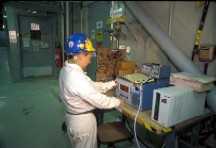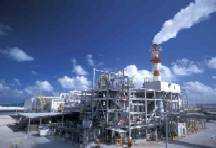Overview of U.S. Chemical Weapons Elimination
Two categories of chemical warfare agents are found in the United States:
- Stockpiled agents.
- Nonstockpiled agents.
In 1986, enactment of PL 99-145 (50 USC 1521) mandated destruction of any stockpiles of lethal chemical agents. In 1997, the United States ratified the Chemical Weapons Convention Treaty. The United States thereby agreed to destroy any remaining stockpiles of chemical warfare agents no later than April 29, 2012 (revised date). Read more about the History of U.S. Chemical Weapons Elimination.
Stockpiled Agents
From World War I to the early 1960s, the amount of chemical warfare agents stockpiled in the United States is thought to have reached nearly 40,000 tons. These chemical warfare agents were stored in bulk containers or as assembled weapons and ammunition at nine sites in the United States. The chemical agents stored at U.S. sites include nerve agents and vesicant, or blister agents.
Nerve Agents
- GA - Tabun or ethyl N,N-dimethyl phosphoroamidocyanidate, CAS 77-81-6
- GB - Sarin or isopropyl methylphosphonofluoridate, CAS 107-44-8
- VX - O-ethyl-S-(2-diisopropylaminoethyl)-methyl phosphonothiolate, CAS 50782-69-9
Vesicant, or Blister Agents
- H, HD - Sulfur mustard, bis-(2-chloroethyl)sulfide, or di-2-chloroethyl sulfide (HD), CAS 505-60-2
- HT - bis(2-chloroethylthioethyl) ether (HT), CAS 63918-89-8
- L - Lewisite or dichloro 2-chlorovinylarsine, CAS 541-25-3
Chemical warfare agents at seven of the nine chemical disposal facility sites have been destroyed and those facilities are closed. Facilities are under construction at the two remaining sites. Read more about Closing U.S. Chemical Warfare Agent Disposal Facilities.
Top of PageNonstockpiled Agents
Some chemical warfare items have not been stockpiled. These nonstockpiled items include
- former chemical weapons production facilities,
- recovered chemical weapons and training materials, and
- miscellaneous equipment (e.g., empty aerial spray tanks).
Some estimates suggest that these items remain at more than 100 sites in the United States and its territories. These items will require management for years to come.
Top of PageCDC Actions to Protect Public Health
The Centers for Disease Control and Prevention (CDC) provides independent oversight to the U.S. Army’s chemical weapons elimination program and serves as an important element in ensuring the safe destruction of chemical warfare material for protection of public health. The team’s focus is prevention with vigilance. Read more about CDC’s role in Elimination of Chemical Weapons.
CDC’s responsibilities for safe chemical warfare agent disposal comprise two major categories: safely dispose of chemical warfare agents and, while doing so, protect public and worker health.
To ensure safe disposal of chemical warfare agents, CDC
- Reviews Department of Defense (DoD) plans for disposing of chemical warfare agents. This review includes staffing and design specifications for system safeguards and for performance. CDC also recommends precautionary measures [PDF - 641 KB] that will avoid potential hazards and will protect public health and safety.
- Ensures that when disposing of chemical warfare agents, DoD provides adequately for public health and for worker safety.
- Observes the required readiness demonstrations before any chemical agent disposal facility begins operations.
- Reviews biweekly reports of air monitoring data for quality assurance.
- Conduct annual, on-site, air monitoring equipment inspections at each operating chemical agent disposal facility.
To protect public health during chemical warfare agent disposal, CDC
- Evaluates the medical program at each chemical agent disposal facility and ensures the medical clinic, the staff, the procedures, and the plans can meet occupational medicine challenges, including emergencies related to chemical agent disposal.
- Assesses the public health effects of any disposal-related, unintended exposure to a chemical warfare agent or agents.
- Works with state and local authorities to respond to public health concerns related to chemical warfare agent disposal.
- Reviews plans for transporting stockpiled and nonstockpiled chemical warfare agents.
- Recommends chemical warfare agent airborne exposure limits that will protect the public and will protect the workers who dispose of those chemical warfare agents.
CDC also provides DoD with recommendations to protect public health and to provide technical assistance regarding:
- Plans to destroy the remaining 2,700 tons of chemical warfare agents, including disposal methods using neutralization followed by biotreatment or supercritical water oxidation.
- Closing chemical disposal facilities, including decontaminating, dismantling, and demolishing the chemical warfare agent disposal equipment and buildings.
- Disposing of nonstockpile chemical warfare agents in the United States and its territories and disposing of chemical weapons previously dumped into the sea.
 Technician Calibrating Air Monitoring Device |
 Chemical Weapons Elimination Facility, Johnston Atoll |
- Page last reviewed: May 31, 2013
- Page last updated: May 9, 2016
- Content source:


 ShareCompartir
ShareCompartir
